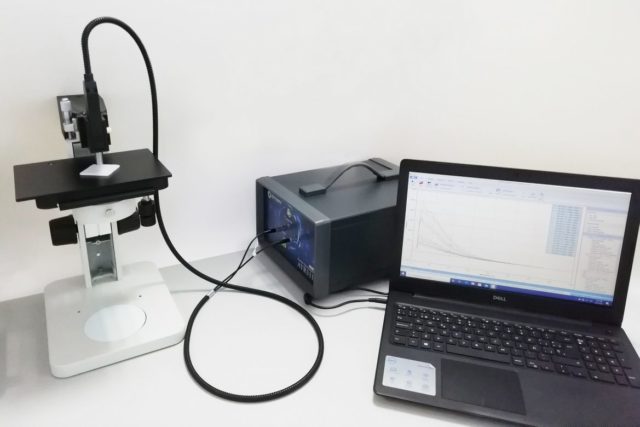Infrared Spectroscopy (IR) and Raman Spectroscopy are the two main methods used to identify molecular vibrational movements. The information regarding molecular vibrations of a molecule assists in determining the molecular structure of a compound. Identifying the molecular structure is key to understanding nature’s creation and movement.
Raman Spectroscopy has several characteristics, that’s why it is often utilized extensively in organic, inorganic, material science, and biological systems. Originally, Raman Spectroscopy was used in the analytical and biological disciplines, but its applications to other areas of research and science continue to expand.
Table of Contents
What is Raman Spectroscopy?
Raman spectroscopy is a molecular spectroscopic technique that uses a light and matter interaction to analyze information about a substance’s chemical properties, polymorphy, crystallinity, and molecular interactions. Spectrographs and extremely sensitive detectors are used in Raman spectroscopy to extract precise and informative spectra. Raman spectroscopy extracts information about intermolecular vibrations to understand a reaction further.
The Raman Scattering
The Raman scattering process happens when photons interact with a molecule in a virtual state or advanced. A photon with a different energy is created when the molecule relaxes to a vibrational energy level different from its initial condition. If the incident photon and the dispersed photon have different energies, there will be a Raman shift.
Strokes Scattering happens when the dispersed photon’s energy change is smaller than the photon that occurs. In comparison, Anti-Strokes occur when certain molecules are new to a virtual state with high energy, which changes to an ultimate energy level lower than the first one. Quantum mechanical Stokes and Anti-Stokes have a similar process.
However, because there are too many molecules, most will undergo vibrational levels. The most expected process would be the strokes scattering since it was more intense than anti-strokes, making it a standard measurement for Raman spectroscopy.
The Raman Effect
The Raman effect occurs when molecules divert a light beam. A minor light fraction appears in different directions when a light beam passes over a chemical compound. The Raman effect is responsible for a small fraction of wavelengths differing from the incident light.
Types of Raman Spectroscopy
1. Raman Spectroscopy
Raman Spectroscopy is an advanced technique for studying vibrational bands in repeated groups. The laser excitation frequency should be close to the electronic transition frequency sample. Raman Spectroscopy technique can enhance signal noise and Raman’s scattering strength with a component of 102-106. Additionally, an excitation laser must be placed close to the right frequency.
2. Surface Enhanced Raman Spectroscopy
Surface-enhanced spectroscopy is a highly selective and sensitive technique in molecular spectroscopic. The laser excitation frequency should be close to a rough metal surface like silver and gold. Surface-enhanced Raman technique is commonly applied in biological studies and microanalysis using a laser beam.
3. Micro-Raman Spectroscopy
Micro-Raman Spectroscopy is a technique for determining the live cells and substances used in tissue engineering. This technique doesn’t spread and requires any sample preparation, like categorization. Raman spectroscopy can evaluate the bioactivity of different biomaterials by observing the development of hydroxycarbonate apatite.
Additionally, this type of Raman Spectroscopy has the potential for tissue engineering by monitoring cell-scaffold structures.
4. Non-linear Raman Spectroscopic Techniques
Nonlinear Raman spectroscopy is a technique based on non-linear effects involving active Raman molecular transitions.
Raman Spectroscopy Application
Raman spectroscopy is used in various disciplines and is useful in situations requiring non-destructive, chemical analysis, microscopic, and imaging. Raman analysis provides essential information for qualitative or quantitative data. Additionally, It can easily define the chemical composition and structure.
The information below summarizes the use of Raman in various disciplines:
Cosmetics and Medicine
- Distribution of compounds in medicine
- High throughput screening
- Blend uniformity
- Makeup content
- Powder clarity
- Verification of raw materials
- Crystallinity
- Identifying contaminants
- Certain areas of chemistry
- Utilizing dosage and content
Carbon Materials
- Clarity of carbon nanotubes (CNTs)
- Electrical components of carbon nanotubes (CNTs)
- Carbon materials structure (sp2 and sp3)
- Hard drives
- Coating properties of jewels
- Analyzation of carbon materials defects
- Electrical components of graphene
Life Science
- Bio-compatibility
- DNA and RNA
- Interactions of drugs and cells
- Photodynamic therapy (PDT)
- Diagnose Disease
- Analyze single-cell
- Sort Cells
- Characterize bio-molecules
- Bone structure
Semiconductors
- Characterize intrinsic stress and strain
- Semiconductors clarity
- Compose alloy
- Identifies contamination
- Hetero-structures
Geology and Minerals
- Analyze minerals and gemstones
- Incorporate fluids
- Distribute mineral
- Phase transition and distribution
- Analyze mineral components
- Recognize chondrite and achondrite meteorites
The Amazing Raman Effect
C.V. Raman’s discovery of the Raman effect profoundly influenced the development of the Raman spectrometer, which is used to identify vibrations, rotations, and other phases in a molecular system that can detect the chemical components of substances.
Raman’s discovery enables us to examine and understand different phenomena, like why there are advanced sunrises and delayed sunsets, why the sky is blue, and why the color red appears during sunrise and sunset.








